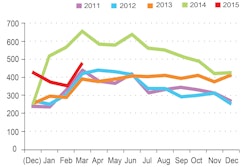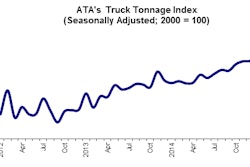
Most are lagging, meaning they show past results rather than predict future ones. And they typically rely on data that is at least a month old, as well as estimated values and qualitative measures like business and consumer sentiment.
By contrast, telematics systems give fleets real-time, measurable data on their business activities and performance. According to a new study from FleetMatics, some of this performance data, if taken collectively, could be used as near-real-time economic indicators.
Fleetmatics provides cloud-based workforce management and telematics applications. Like many technologies of this type, the software captures a range of performance metrics like mileage, number of vehicle stops, and mileage per stop. While fleets use these metrics internally, they are also highly credible indicators for national and regional economic health, the study says.
To conduct the study, Fleetmatics partnered with Dr. Stephen Fuller, a university professor and director of the Center for Regional Analysis at George Mason University. Fleetmatics tracks the activities of approximately 552,000 residential and commercial service and delivery vehicles for over 25,000 businesses. Dr. Fuller used this data stored on Fleetmatics’ servers in the cloud to develop a data set that is representative of the activities of service-based small businesses.
Regression analysis was used to compare 10.7 billion telematics-generated data points from over 400,000 commercial vehicles to nearly four years of monthly retail sales data from Moody’s and the U.S. Bureau of Census. The data from the two sets covered the same periods dating back to January 2011.
“What we found was an extremely high correlation between the retail data at both the national and metropolitan area levels,” he stated. “I believe the ability to analyze real-time telematics data can now be considered an accurate data source on the small business flow of goods and service.”










